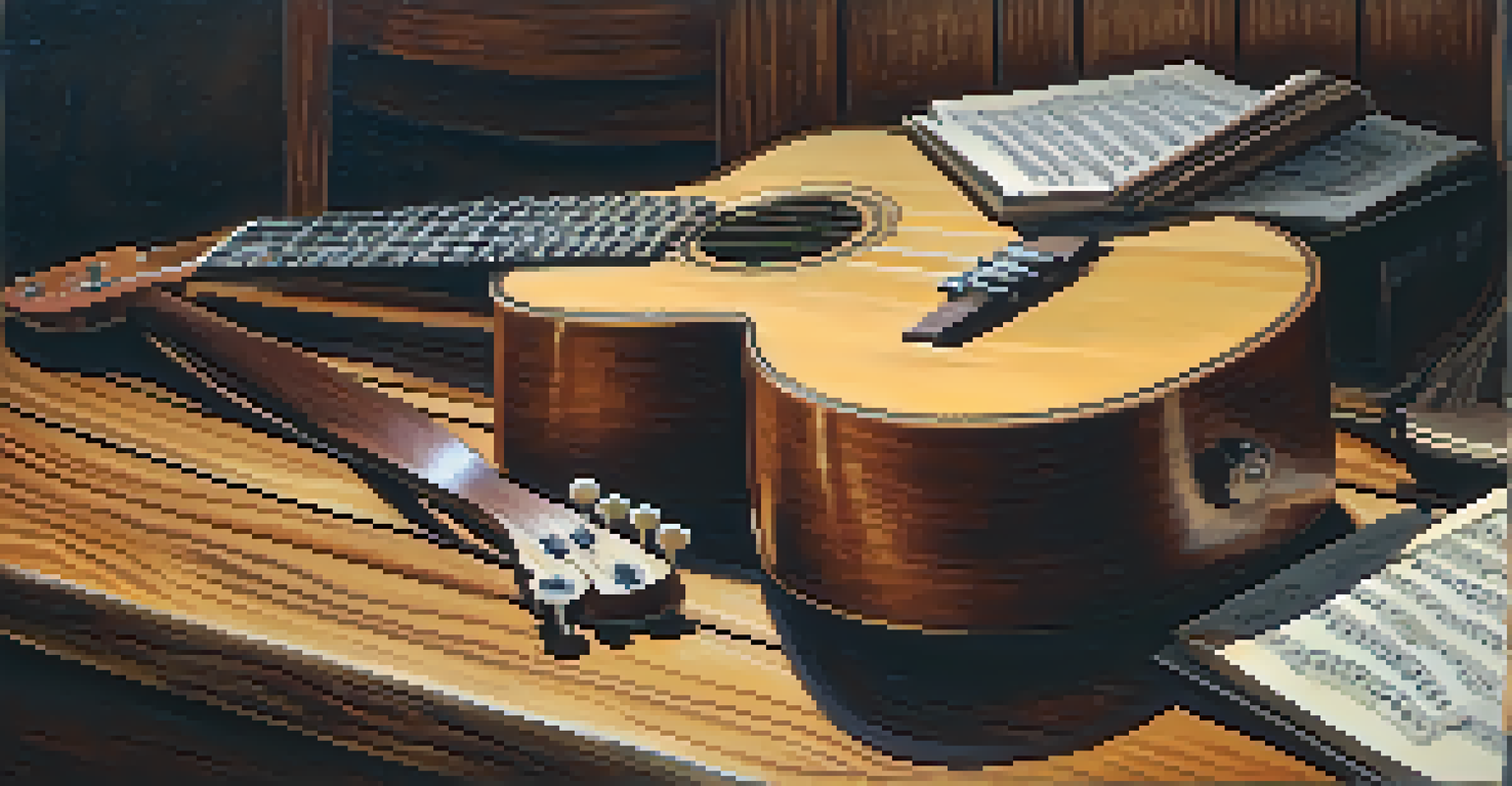Integrating Ukulele with Guitar: Harmonies and Rhythms Together

The Unique Sounds of Ukulele and Guitar
The ukulele and guitar each bring their own unique sound and character to music. While the guitar offers a deep, resonant tone, the ukulele shines with its bright, cheerful notes. This contrast creates a wonderful opportunity for musicians to explore new textures in their compositions. Imagine a sunny beach day—where the gentle strum of the ukulele complements the rich chords of a guitar, creating a delightful atmosphere.
The ukulele is the perfect instrument for those who want to create music that is light and joyful.
Understanding the distinct qualities of each instrument can help musicians appreciate their potential when paired together. For instance, the ukulele’s higher pitch can cut through the mix, making melodies more pronounced. On the other hand, the guitar’s versatility allows it to support a wide range of genres, from folk to rock. Together, they can create a layered sound that is both engaging and refreshing.
As musicians begin to integrate these two instruments, they’ll find that their combined sounds can evoke a range of emotions. The interplay of the ukulele's lighthearted strumming with the guitar's rhythmic chords can transform a simple tune into something extraordinary. This unique blend invites listeners to experience music in a new light.
Basic Chord Progressions for Both Instruments
To get started with integrating the ukulele and guitar, it’s essential to have a solid grasp of basic chord progressions. Common progressions, such as C-G-Am-F, work beautifully on both instruments. A guitarist can strum these chords while a ukulele player complements with higher-pitched variations. This creates a cohesive sound that is pleasing to the ear and easy to play.

One way to practice these progressions is by focusing on the rhythm. For example, while the guitar maintains a steady strumming pattern, the ukulele can introduce syncopation or a more playful rhythm. This not only enhances the musical conversation between the two instruments but also keeps the performance engaging for both players and listeners.
Unique Sounds of Ukulele and Guitar
The contrasting tones of the ukulele and guitar create diverse musical textures that enhance compositions.
Experimenting with different chord progressions allows musicians to discover their unique sound. By layering the ukulele's chords over the guitar's, players can create rich harmonies that elevate their music. It's this collaborative spirit that makes integrating these instruments so rewarding.
Creating Harmonies: Melody and Chord Work
Harmonies are the heart of music, and integrating the ukulele and guitar opens up a world of possibilities. A good starting point is to have the guitar play the core chords while the ukulele weaves in melodies that complement those chords. This relationship allows the ukulele to shine, adding a layer of brightness to the overall sound.
The guitar is a remarkable instrument, and it can do so much. The range of sounds, the different styles, the many forms of music it can create are endless.
When crafting harmonies, it’s helpful to consider the scale being used. For instance, if both instruments are in the key of C, the ukulele can play notes from the C major scale to create a melody that fits beautifully with the guitar's chords. This creates a harmonious blend that is both simple and effective, showcasing the strengths of each instrument.
As musicians become more comfortable with harmonizing, they might explore incorporating additional techniques, such as fingerpicking on the guitar or using various strumming patterns on the ukulele. These elements can add depth and complexity to the music, turning a simple duet into a rich tapestry of sound.
Rhythmic Patterns: Staying in Sync
Rhythm is essential when integrating the ukulele and guitar. Both instruments should work together to create a cohesive feel that drives the music forward. This means paying attention to timing and ensuring that both players are in sync with their strumming or picking patterns.
One effective way to practice synchronization is through simple exercises. For instance, one player can establish a steady beat while the other adds variations in rhythm. This not only helps build a strong foundation for their performance but also fosters a sense of teamwork and musical connection.
Harmonizing for Emotional Depth
Combining melodies from the ukulele with guitar chords allows musicians to craft rich harmonies that elevate their music.
As musicians become more comfortable with their rhythmic interplay, they can experiment with more complex patterns. For example, the guitar might switch between strumming and fingerpicking, while the ukulele can maintain a steady rhythm. This dynamic exchange can lead to exciting musical moments that captivate audiences.
Songwriting with Ukulele and Guitar
Songwriting is a wonderful way to explore the integration of ukulele and guitar. By starting with a simple chord progression on the guitar, songwriters can build a solid foundation for their composition. Once the chords are established, they can layer the ukulele to introduce melodies or counterpoints that enhance the song's emotional depth.
Incorporating both instruments into the songwriting process allows for a richer creative experience. For example, a guitarist might write a heartfelt verse, while the ukulele adds an uplifting chorus. This contrast can create a compelling dynamic that keeps listeners engaged and invested in the music.
Additionally, collaborating with other musicians who play these instruments can spark new ideas and perspectives. Sharing songs and experimenting with different arrangements can lead to unexpected and beautiful outcomes. The fusion of the ukulele and guitar can result in unique compositions that showcase the strengths of both instruments.
Performance Tips for Duets
Performing as a duo with a ukulele and guitar can be an exhilarating experience, but it also requires some preparation. To ensure a successful performance, it's important for both musicians to communicate openly about their roles and expectations. Whether one is taking the lead or sharing the spotlight, clarity can make all the difference.
Another key aspect of performing together is to practice regularly. Rehearsing not only helps build confidence but also allows musicians to experiment with different arrangements and styles. This can lead to discovering new layers within songs and enhancing the overall performance quality.
Versatility Across Musical Genres
Both the ukulele and guitar can adapt to various genres, offering limitless creative possibilities for musicians.
Lastly, engaging with the audience is crucial during a performance. Whether it's through eye contact, smiles, or even a bit of banter, connecting with listeners can elevate the experience. A lively interaction between the musicians and the audience can create an unforgettable atmosphere that leaves a lasting impression.
Exploring Genres: Versatility of the Ukulele and Guitar
One of the most exciting aspects of integrating ukulele and guitar is their versatility across various genres. From folk and pop to jazz and blues, both instruments can adapt to different styles, allowing musicians to explore a wide range of musical expressions. This flexibility makes them an ideal pairing for creative experimentation.
For instance, in a folk setting, the guitar might provide a steady rhythm while the ukulele adds playful melodies and harmonies. Conversely, in a jazz context, the ukulele can take on a more sophisticated role, playing intricate chords and syncopated rhythms alongside the guitar's improvisations. This ability to blend seamlessly into different genres showcases the potential of these two instruments.

As musicians continue to explore these genres, they can discover their unique sound and style. By experimenting with different techniques and approaches, they can create music that reflects their personality and artistic vision. The journey of integrating ukulele and guitar is not just about the instruments, but also about the stories and emotions they convey together.